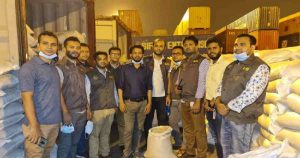Jessore, Mar 3 – Residents of a cluster of villages in Jashore have taken an initiative to drain the water of 27 beels, including Beel Khukshia on their own accord, as the Water Development Board (WDB) has not been able to solve the waterlogging problem in the area for a long time. People of 69 villages organised under the banner of Jolaboddhota Niroshon Bastobayon Committee (Waterlogging Elimination Implementation Committee). They started this irrigation program on January 15 using 129 irrigation pumps, all arranged with their own funds. If the water drainage program is successful, around 3.5 lakh people stand to benefit, with about 24,000 bighas of land to be freed up for paddy farming.
The water is being drained with 129 different-sized irrigation pumps in a row along the Hari river dam in Dahuri village of Sufalakati union at Keshabpur Upazila.
Leaders of the Waterlogging Elimination Implementation Committee said the location of 27 beels, including Bill Khukshia, runs from Dumuria Upazila in Khulna district to Keshabpur and Monirampur Upazilas in Jessore. Pazia and Suflakati Unions of Keshabpur, and Durbadanga and Manoharpur Unions of Monirampur are among the four unions.
The people of all 69 villages have been suffering from waterlogging for a long time due to the negligence of WDB.
Awami League leader and treasurer of the Committee Manjur Rahman said in the past, the water from these beels was drained through the Hari River. But as the river gradually got occupied, the drainage of the beel became blocked.
Since then farming has stopped in these beel areas. Then the fish farms of these areas were formed.
“Since this problem has not been solved for a long time, we have started draining this year. Each machine owner is being paid TK. 500 per day and the diesel is funded by the committee. A total of 24 people including Abdul Halim, Azizur Member, Fazlur Rahman, Pradeepta Biswas and Mashiur Rahman have been appointed for this work,” said Manjur.
For drainage TK. 1000 per bigha is being taken from the owners of land and ponds. All expenses are being met with this money. So far, about 13,000 bighas of land have been made cultivable which means over half the work on the land is done.
Hopefully, it will be possible to drain the water within the next month. Convener of the committee and president of Keshabpur Upazila Awami League SM Ruhul Amin said their hand was forced in the matter of trying to solve the waterlogging problem on their own. Waiting for the government had only brought suffering for the residents of the 69 villages. Things had reached a point where they could not afford to suffer any more. There are 26 beels linked with this beel.
Crops in Keshabpur and Monirampur have not been harvested for a long time. Cows, goats, people were dying. I started this work thinking about them. After learning about the history of the area’s agriculture, it became clear that a mistake had been made by discontinuing the practice of Tidal River Management in the region.
TRM had emerged as a technique in the same region of southwest Bangladesh in the late Eighties after many tidal rivers in the region became filled with sediment. This led to permanent waterlogging caused by riverbed sedimentation. in areas around Khulna, Jessore and Satkhira, which had detrimental consequences for agriculture.
In 1997, during the Khulna-Jessore Drainage Rehabilitation Project (KJDRP), the local population of Beel Bhaina created a tidal basin by cutting the embankment with the Hari river. This had two effects: firstly, a gradual rise in the level of the land in Beel Bhaina with sediment, coupled with an increased cross-section of the Hari River.
Drainage of the entire KJDRP area improved after the cut. The strategy of creating temporary tidal basins was given the name “Tidal
River Management”. During the period TRM was introduced in Jashore, many lands were harvested. The river Hari regained its depth. But later it was discontinued over some other dispute.
Water Development Board Jessore Executive Engineer Tahidul Islam said a big project has been undertaken to reintroduce TRM in the beels. Various experiments are being carried out on its implementation. If it can be implemented, the villagers will at least have a way to ward off waterlogging in the beels. – UNB




